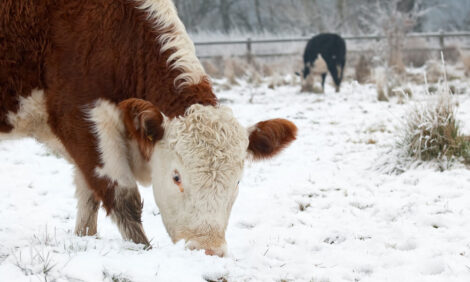



LMC: 4% Decline In Cattle Kill Confirmed For 2011
NORTHERN IRELAND, UK - Last year was a remarkable year for deadweight cattle prices, according to the Livestock and Meat Commission of Northern Ireland.In Northern Ireland, prime
cattle prices were generally 14 per cent
higher than 2010 levels throughout 2011 and to a
large extent the strong prices were driven by the
tight supply situation throughout Ireland.
Table 1 below shows how the cattle kill in
Northern Ireland was significantly lower in 2011
compared to 2010 levels. Over the course of the
year the total prime cattle kill was six per cent lower
than 2010 levels. However, with a 14 per cent
increase in the cull cow kill, the impact on
throughput at the factories in 2011 was softened to
a certain extent with the overall kill down by four
per cent.
2011 was bookended by a very large cattle kill in
both January and December. Last January, the kill
was significantly higher than previous year levels,
while in December the general trend of tight
availability throughout 2011 was broken with a four
per cent increase in the prime cattle kill (a
reflection of the big freeze in December 2010).
With heavier carcase weights also, overall prime
beef production was six per cent higher than
December 2010 levels. With the cow kill up by 24
per cent year-on-year, the overall kill was up by
seven per cent in December.
The stronger kill in December meant that the
overall decline in slaughterings in 2011 was not just
as steep as it may have been otherwise. By the end
of 2011, the steer kill was down by two per cent
compared to 2010 levels. However, the young bull
/ calf kill was down by 17 per cent on 2010 levels,
meaning that the overall male prime cattle kill was
down by seven per cent. This reflected the reduced
number of cattle on the ground over the course of
last year.
The mature bull kill was down (-34 per cent)
sharply also. It is important to note that this does
not represent a liquidation of the breeding bull kill
and rather is a reflection of the reduced number of
male beef cattle being kept entire and fed beyond
24 months (the age at which a young bull is
deemed to become a mature bull).
The five per cent decline in the heifer kill also
reflected this lower number of cattle on the ground.
The reduced heifer kill also corresponded with
increased retentions of heifers in 2011 for
breeding. This would have reduced the number
available for slaughter.
With more heifers retained for breeding and strong
cull cow prices, there was a significant 14 per cent
increase in the number of cows slaughtered in
2011 compared to 2010. This was driven mainly by
an increase in the beef cow kill.
Lamb kill down by 13 per cent
In 2011, the lamb kill was significantly lower than
2010 levels. By the end of September, the kill for
the year to date was running at 25 per cent lower
than 2010 levels. However, with a substantial uplift
in the kill in the final quarter, the overall kill for
2011 was just 13 per cent lower than 2010 levels.
In December the NI lamb kill was 50 per cent
(10,000 head) higher than 2010 levels. This is a
substantial increase and reflects a trend which was
ongoing throughout the entirety of the final quarter
of 2011. It does not appear that this increase has
been at the expense of exports to ROI and it
remains to be seen whether throughput in early
2012 will be tighter as a result of this increased kill
in late 2011.
Further Reading
| - | You can view the full report by clicking here. |
TheCattleSite News Desk


